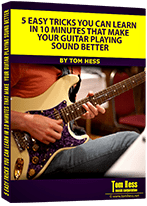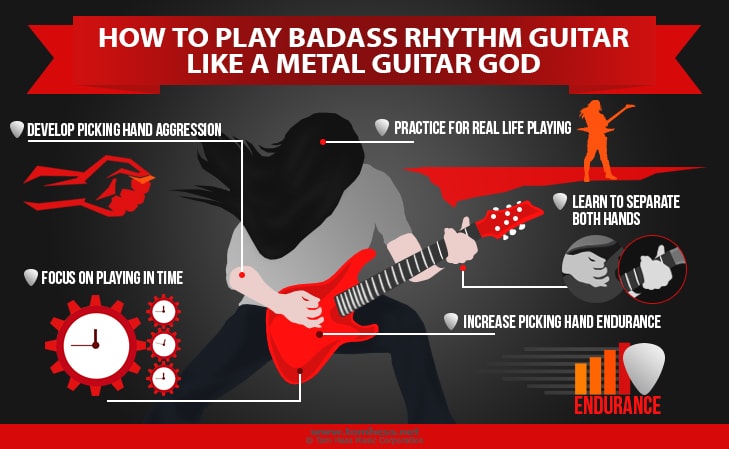Want to play ass-stomping rhythm guitar riffs?
Then change your practicing focus from “finding cool guitar riffs to play” to “learning to make ANY riff you play sound killer and tight”.
Similar to great guitar solos, the difference between a rhythm guitar riff sounding awesome or just average is how it is played.
Here are 5 main things you must work on to master rhythm guitar playing:
1. Use Powerful Pick Attack In Your Rhythm Guitar Riffs
Many guitarists play rhythm guitar using too little power in their picking hand.
This often happens when you want to play fast and your picking hand begins to sacrifice power for speed (making your playing sound weak).
The secret to playing fast and powerful rhythm guitar riffs (without becoming tired) is to hit the strings hard and then relax that power/tension after playing each note or chord.
This way tension doesn't build up throughout you hand and arm, making riffs harder to play. (More on how to do this below.)
Learn In 10 Minutes

EMAIL TO GET ACCESS
By submitting your info, you agree to send it to Tom Hess Music Corporation who will process and use it according to their privacy policy.
2. Learn To Play Rhythm Guitar Really Tight
For most guitarists, training their rhythm guitar playing is limited to “practicing to a metronome”. Fact is, truly tight playing consists of mastery and integration between the following elements:
- Playing with perfect intonation on all strings when strumming power chords (or other chords). This is especially key if you are double (or quad) tracking your rhythm guitar parts for recording.
- Eliminating ringing noises from strings that are not being played.
- Eliminating unwanted squeaks or scratchy noises when changing chords.
- Avoiding hitting strings that are not part of the riff (or chord) you are playing.
- Avoiding sloppy noises during rests in the music (between notes/chords).
- Maintaining perfectly consistent palm muting for every note or chord you play.
- Playing pinch harmonics in key and having the accompanying vibrato match the rhythm of the music.
- Doing all of the above with totally rock-solid timing.

Master rhythm guitarists have practiced and developed all of the above elements to a very high level. To join them, you must do the same. The first step towards mastery is to assess how well you can currently hear the difference between truly tight rhythm guitar playing and playing that is not very tight. To test yourself, take 2 minutes to complete this rhythm guitar skills assessment.
If you don’t already know how to correctly practice the elements of tight rhythm guitar playing, get a great guitar teacher to help you master them.
 How To Play Awesome Guitar Riffs
How To Play Awesome Guitar RiffsFind out how to play killer rhythm
guitar riffs in a rock/metal style.
 10 Ways To Improve As A Guitarist
10 Ways To Improve As A GuitaristLearn 10 things that will help you quickly become a better guitarist.
 Learn What To Practice On Guitar
Learn What To Practice On GuitarLearn how to become a balanced
guitarist and fix your weaknesses.
3. Practice Playing Rhythm Guitar For Real-Life Situations
Unless you intend to only play guitar for yourself, you must practice making your rhythm guitar playing reliable when playing in front of others (and/or in the studio). It’s one thing to play perfectly for yourself, it’s another thing to do this when playing for real. Most guitarists never specifically practice for real-life playing, because:
1. They never had a great guitar teacher to show them how to do this correctly.
2. They falsely assume that their real-life playing skills will “develop on their own” as they simply play guitar more.
To learn how you should practice your rhythm guitar riffs to prepare for real-life playing, read this article about playing guitar live.4. Learn How To Separate Your Picking Hand From Your Fretting Hand
One of the most common rhythm guitar mistakes is to tense up your fretting hand as your picking hand plays faster (and/or with more articulation and power). This makes rhythm guitar playing much harder than it needs to be and makes your hands tired a whole lot faster.
The solution is to (mentally) separate the hands when practicing your rhythm guitar riffs. It doesn't matter how hard (or how soft) your picking hand is hitting the strings - your fretting hand must not change the amount of tension it uses to play notes. As a general rule, your fretting hand needs a whole lot less power and strength to fret notes than the picking hand does to play rhythm guitar.
You should constantly be paying attention to the tension levels in your hands/arms as you play. Rotate your focus when practicing and make sure that each hand uses appropriate amounts of tension for the job it has to do.5. Train For Long-Lasting Endurance (Ability To Play Tight Rhythm Guitar For Long Periods Of Time)
In addition to managing excessive tension in your hands, rhythm guitar endurance is developed through specialized training in this area of playing. This training is done to maximize how long you can play your rhythm guitar parts accurately and consistently at the fastest speed possible.
There are 3 variables involved in training for rhythm guitar endurance:
- Control over general rhythm guitar tightness and accuracy (the elements listed earlier in the article)
- The speed at which you can play perfectly.
- The amount of time you can maintain control/accuracy/tightness at that speed.
Training for rhythm guitar endurance is best done on 2 different levels:
Level 1: Select a guitar riff that you want to build endurance with, set a time goal and practice to increase the speed at which you can play perfectly for that amount of time without becoming tired. For example, play your guitar riff for 30 seconds non-stop at 100 beats per minute on the metronome. Then (if it feels too easy), increase the metronome by a few beats per minute and repeat the process for another 30 seconds. Continue doing this until you hit a metronome tempo where you cannot play perfectly for 30 seconds without becoming tired. You will then keep practicing until you can stay at this speed for 30 seconds, playing accurately and tight.
Level 2: Select a certain metronome tempo and try to play your rhythm guitar riff for as long as possible at that speed. When you are able to beat your previous time (play longer than you have in the past), you will know that your endurance has improved.
Combining these 2 approaches will help you master this area of rhythm guitar playing fully.
It doesn't matter what rhythm guitar riffs or specific exercises you use for this training -you can go through this process with any riff you practice.
Note: If you ever feel pain while practicing guitar, this is a sign that you should STOP – never attempt to play through pain!
Now that you know the key elements needed for playing badass rhythm guitar, test yourself to see how close you currently are to mastering this area of your guitar playing. Take a few minutes to complete this rhythm guitar playing assessment and get my free feedback that will help you become a much better rhythm guitar player.

